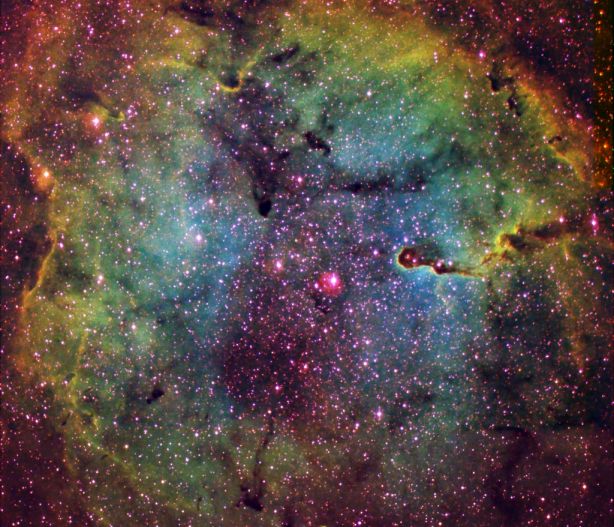Credit & Copyright: Richard Crisp
Explanation:
Sprawling
across hundreds of light-years, emission
nebula IC 1396 mixes glowing cosmic gas and
dark dust clouds.
Stars are forming in this area, only about 3,000 light-years
from Earth.
This
particularly colorful view
of the region is a composite
of digital images recorded through narrow band filters.
The filters actually
block out most of the light ...
but narrowly transmit
wavelengths characteristic of
specific glowing atoms in the nebula.
In fact, the
color scheme used here makes
it easy to trace some of the
elements which contribute
to the emission from IC 1396.
Emission from sulfur atoms is shown in red,
hydrogen atoms green, and oxygen in blue.
The beautiful and useful result is still very different from
what the eye might see.
IC 1396 lies in the high and far off constellation
of Cepheus.
1999 2000 2001 2002 2003 2004 2005 2006 2007 2008 2009 2010 2011 2012 2013 2014 2015 2016 2017 2018 2019 2020 2021 2022 2023 2024 2025 |
Yanvar' Fevral' Mart Aprel' Mai Iyun' Iyul' Avgust Sentyabr' Oktyabr' Noyabr' Dekabr' |
NASA Web Site Statements, Warnings, and Disclaimers
NASA Official: Jay Norris. Specific rights apply.
A service of: LHEA at NASA / GSFC
& Michigan Tech. U.
|
Publikacii s klyuchevymi slovami:
emission nebula - star formation - hydrogen - emissionnaya tumannost' - zvezdoobrazovanie - vodorod
Publikacii so slovami: emission nebula - star formation - hydrogen - emissionnaya tumannost' - zvezdoobrazovanie - vodorod | |
Sm. takzhe:
Vse publikacii na tu zhe temu >> | |
